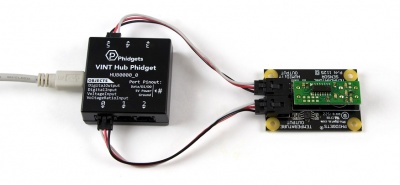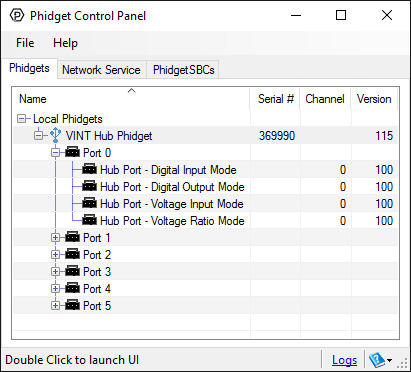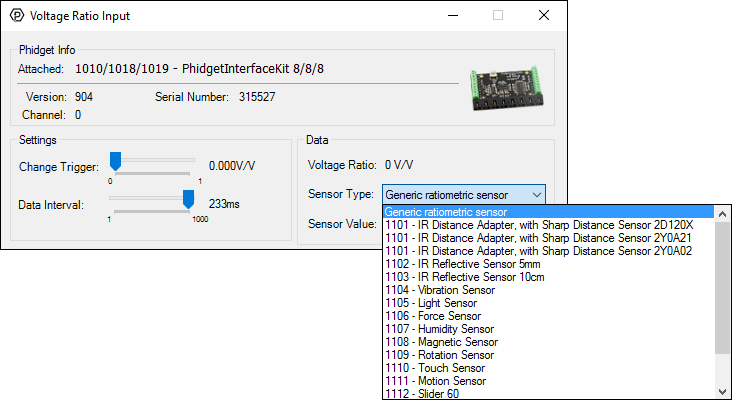1125 User Guide
Getting Started
Welcome to the 1125 user guide! In order to get started, make sure you have the following hardware on hand:
- 1125 - Humidity/Temperature Sensor
- Any Phidget with a Analog Input or VINT port, here are some compatible products. We will be using the VINT Hub for this guide.
- USB cable and computer
- Phidget cable
Next, you will need to connect the pieces:

- Connect the 1125 temperature output to the HUB0000 using one of the Phidget cables.
- Connect the 1125 humidity output to the HUB0000 using the second Phidget cable.
- Connect the HUB0000 to your computer with the USB cable.
Now that you have everything together, let's start using the 1125!
Using the 1125
Phidget Control Panel
In order to demonstrate the functionality of the 1125, we will connect it to the HUB0000, and then run an example using the Phidget Control Panel on a Windows machine.
The Phidget Control Panel is available for use on both macOS and Windows machines. If you would like to follow along, first take a look at the getting started guide for your operating system:
Linux users can follow the getting started with Linux guide and continue reading here for more information about the 1125.
First Look
After plugging in the 1125 into the HUB0000, and the HUB0000 into your computer, open the Phidget Control Panel. You will see something like this:

The Phidget Control Panel will list all connected Phidgets and associated objects, as well as the following information:
- Serial number: allows you to differentiate between similar Phidgets.
- Channel: allows you to differentiate between similar objects on a Phidget.
- Version number: corresponds to the firmware version your Phidget is running. If your Phidget is listed in red, your firmware is out of date. Update the firmware by double-clicking the entry.
The Phidget Control Panel can also be used to test your device. Double-clicking on an object will open an example.
Voltage Ratio Input
Double-click on a Voltage Ratio Input object in order to run the example:

General information about the selected object will be displayed at the top of the window. You can also experiment with the following functionality:
- Modify the change trigger and/or data interval value by dragging the sliders. For more information on these settings, see the data interval/change trigger page.
- Select the 1125 from the Sensor Type drop-down menu. The example will now convert the voltage into temperature (°C) and humidity (% RH) automatically. Converting the voltage to temperature (°C) and humidity (% RH) is not specific to this example, it is handled by the Phidget libraries, with functions you have access to when you begin developing!
Finding The Addressing Information
Before you can access the device in your own code, and from our examples, you'll need to take note of the addressing parameters for your Phidget. These will indicate how the Phidget is physically connected to your application. For simplicity, these parameters can be found by clicking the button at the top of the Control Panel example for that Phidget.

In the Addressing Information window, the section above the line displays information you will need to connect to your Phidget from any application. In particular, note the Channel Class field as this will be the API you will need to use with your Phidget, and the type of example you should use to get started with it. The section below the line provides information about the network the Phidget is connected on if it is attached remotely. Keep track of these parameters moving forward, as you will need them once you start running our examples or your own code.

Using Your Own Program
This sensor produces an analog signal between 0-5V depending on the input temperature or humidity. This signal is measured by the Phidget it is plugged into, such as the HUB0000 or the 1018, and interpreted by the Phidget library. You will need to reference the User Guide and API for that Phidget for more information on how to use this type of device in your program. For more information about the signal produced by this device, check out the Voltage Ratio Input Primer.
You are now ready to start writing your own code for the device. The best way to do that is to start from our examples:
When used with a Phidget that measures the signal from this sensor, this Phidget is compatible with our VoltageRatioInput Examples. They outline the use of the VoltageRatioInput API, which is used to interpret the signal from this device.
Once you have your example, you will need to follow the instructions on the page for your programming language to get it running. To find these instructions, select your programming language from the Software Overview page.
Technical Details
General
The 1125 is a precision temperature to voltage converter that outputs a voltage that is directly proportional to temperature. The temperature sensor component is rated at -40°C to +100°C, but the other components on the board, the connector and the cable are rated at -30°C to +80°C. In a fast prototyping environment the 1125 can be pushed to the ratings of the sensor component, but you should use the lower temperature ratings if you plan to use the 1125 in a commercial application.
The 1125 measures the relative humidity of the environment around the sensor. Built in temperature compensation produces a linear output ranging from 10% to 95% relative humidity. Values outside of this range may be usable but will have increased error.
Formulas
The Phidget libraries can automatically convert sensor voltage into temperature (°C) and humidity (% RH) by selecting the appropriate SensorType. See the Phidget22 API for more details. The formulas used to translate voltage ratio from the sensor into temperature and relative humidity are as follows:
Phidget Cable

The Phidget Cable is a 3-pin, 0.100 inch pitch locking connector. Pictured here is a plug with the connections labelled. The connectors are commonly available - refer to the Analog Input Primer for manufacturer part numbers.
What to do Next
- Programming Languages - Find your preferred programming language here and learn how to write your own code with Phidgets!
- Phidget Programming Basics - Once you have set up Phidgets to work with your programming environment, we recommend you read our page on to learn the fundamentals of programming with Phidgets.


